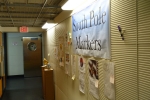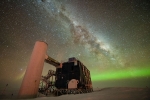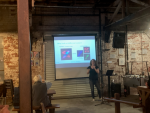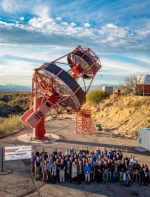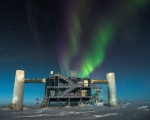Friday, June 19, 2020 - 8:45am
They got some great outdoor photos last week under bright moonlight—no headlamps needed to walk around outside.
Monday, June 15, 2020 - 10:00am
Submitted ideas for the next pole marker are on display. The winterovers will vote on their favorite design for the 2021 marker.
Friday, June 5, 2020 - 11:15am
OK, so the weather’s cold (June average of -64° F), but there was lots of “cool” stuff at the Pole last week for IceCube’s winterovers.
Wednesday, June 3, 2020 - 6:00pm
We are outraged by the death of Mr. George Floyd.
Monday, June 1, 2020 - 2:00pm
University of Wisconsin–Madison graduate student Leslie Taylor spent four months in Arizona recently. Her research group needed her to lead commissioning and other hands-on work with the prototype Schwarzschild-Couder telescope (pSCT) at the Fred Lawrence Whipple Observatory on Mount Hopkins.
Monday, June 1, 2020 - 2:00pm
Scientists in the Cherenkov Telescope Array (CTA) consortium have detected gamma rays from the Crab Nebula using the prototype Schwarzschild-Couder Telescope (pSCT), proving the viability of the novel telescope design for use in gamma-ray astrophysics. The announcement was made today by Justin Vandenbroucke, associate professor at the University of Wisconsin–Madison, on behalf of the CTA Consortium at the virtual 236th meeting of the American Astronomical Society (AAS).
Friday, May 29, 2020 - 10:00am
It’s cold at the South Pole, no matter how you slice and dice it. And as winter settles in, temperatures go even lower.
Wednesday, May 27, 2020 - 9:30am
Last week was a relatively quiet week at the Pole. Well, quiet as far as the IceCube detector was concerned, but there were a variety of things going on as usual.
Friday, May 15, 2020 - 12:00pm
The recent photos from the Pole reflect a peacefulness outside, with the impending darkness of winter still held off by a bright moon
Friday, May 15, 2020 - 8:00am
Some of WIPAC's computing resources are beingused to simulate protein folding of SARS-CoV-2, the coronavirus responsible for COVID-19. How proteins fold into three-dimensional shapes is difficult to predict but has big effects on biological interactions, like those between a virus and its host. These simulations will help researchers understand how the virus compromises human immune systems and reproduces.


